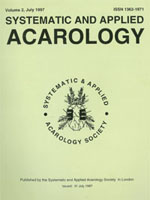Risk of infection with most tick-borne pathogens depends directly on the duration of tick attachment. To determine the duration of attachment of nymphal and adult female Ixodes scapularis Say, previous studies have used polynomial regression to model tick engorgement with a fixed time of initial tick attachment. We studied the impact of the time of day of initial tick attachment on engorgement rates in the nymphal stage, and found that ticks attaching early in the photophase engorged at significantly slower rates than ticks attaching later. We propose an improved method of predicting duration of tick attachment that incorporates this variability in tick engorgement rates. A graphical method is presented to facilitate prediction.
How to translate text using browser tools
1 July 1999
An improved method for predicting duration of blacklegged tick (Ixodes scapularis) attachment
Colleen Kelly,
Erin Kammann,
Jason M. Bak,
Thomas N. Mather
ACCESS THE FULL ARTICLE

Systematic and Applied Acarology
Vol. 4 • No. 1
July 1999
Vol. 4 • No. 1
July 1999
deer tick bites
duration of attachment
engorgement indices
Ixodes scapularis
Lyme disease




